The Hobbit: An Unexpected Journey
 for extended sequences of intense fantasy action violence, and frightening images.
for extended sequences of intense fantasy action violence, and frightening images.
Reviewed by: John M. Decker
CONTRIBUTOR
| Moral Rating: | Average |
| Moviemaking Quality: |
|
| Primary Audience: | Family Teens Adults |
| Genre: | Adventure Fantasy Drama Adaptation IMAX 3D |
| Length: | 2 hr. 46 min. |
| Year of Release: | 2012 |
| USA Release: |
December 14, 2012 (wide—4,000+ theaters) DVD: March 19, 2013 |
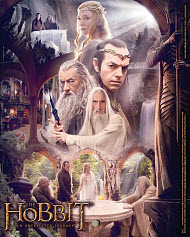

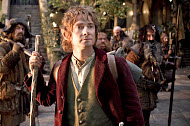

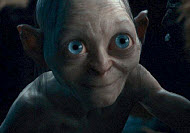
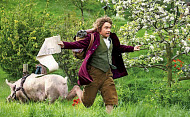
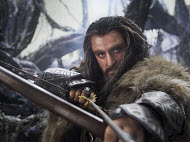
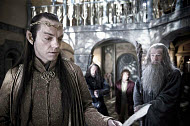


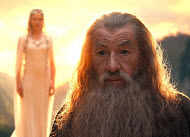

novel: The Hobbit, or There and Back Again by J.R.R. Tolkien
courage / bravery
dragons and dinosaurs—discover how they are connected
dragons in the Bible
wizards and sorcerers
The Lord of the Rings: The Fellowship of the Ring (2001)
| Featuring |
|---|
|
Benedict Cumberbatch … The Necromancer Hugo Weaving … Elrond Martin Freeman … Bilbo Baggins Evangeline Lilly … Tauriel Luke Evans … Bard Cate Blanchett … Galadriel Elijah Wood … Frodo Christopher Lee … Saruman Orlando Bloom … Legolas Ian McKellen … Gandalf Richard Armitage … Thorin Oakenshield Andy Serkis … Gollum See all » |
| Director |
|
Peter Jackson |
| Producer |
|
New Line Cinema Metro-Goldwyn-Mayer (MGM) See all » |
| Distributor |
“From the smallest beginnings come the greatest legends.”
Sequels: “The Hobbit: The Desolation of Smaug” (2013), “The Hobbit: The Battle of the Five Armies” (2014)
A precursor to my review: Upon finishing my review, I am left with the impression that it is primarily negative. I do not mean to convey a negative view of this film. It’s a wonderful film. It’s a fun adventure which is more wholesome than the majority of films on the market. It is a wonderful children’s tale that I thoroughly enjoyed, and there is little that I find personally objectionable. I look forward to the rest of the series. I plan to buy it and watch it with my family many times in the future. Keep in mind, the key purpose of my review is to act as a kind of gatekeeper for what is ahead. An excellent and thrilling tale lies ahead. For those with small children—some warnings. For the rest of us, be vigilant always and enjoy this gorgeous, colorful, compilation of sight and sound once imagined, now on the screen.
A beautifully made, inspiring adventure story, an action film for the young, but no too young. There is something so innocent in the telling of The Hobbit when it is read to children, and this was the author’s intention. Dark aspects are quickly put out like flickering candles. They sneak up and make the heart race. Like a scary campfire story, they startle and are whisked away by the jolly voice of a father seeking to warn of evil but not terrify his little ones. This is not so much the case with the film “The Hobbit.” Peppered with humor and intrigue worthy of this small children’s book, the film has playful aspects of the myth—dwarves and their bumbling nature, innocence of hobbits, dumbness of orcs, thugginess of evil characters. However, if you guessed this film might be a little more like The Hobbit—primarily a children’s tale—than The Lord of the Rings—a darker and more intricate set of stories designed for an older crowd that’s more familiar with the depravity of the world, you would be like I was—wrong.
Yes, it’s somewhat playful, but there are portions dark enough to scare not only children, who are not accustomed to dark imagery, but some who are. I would not entirely disagree with the PG-13 rating due to the darker aspects of the film. It is certainly not darker than the LOTR series, so that’s a good gauge. If you are familiar with the LOTR movies or the book The Hobbit, you would expect a general lack of: cursing, dirty behavior, sexuality and general elevation of bad character in this film. “The Hobbit” delivers on that expectation.
Hope, loyalty, diligence, the value and appreciation of innocence, valiance, patience, trust, need for diversity, kindness, masculinity, honor, vision, determination—these characteristics are frequent among the heroes of this film. Tolkien, like C.S. Lewis, is known for his righteous heroes, and this film quite reflects the same. This is a heartwarming story of loyalty and purpose that warns of greed, but still seeks treasure and a restored heritage. Sometimes it is those who warn us of the evils of capital who secretly are thieves or working on the side of evil.
My sons, 14 and 16, and I quickly agreed that this film has more witchcraft than the LOTR series. It is seen throughout a number of scenes, instead of appearing only here or there with some words or a healing potion. On top of this, there is a difference in the portrayal of wizardry: With the appearance of Radagast the Brown comes a wizard more like a genuine modern day witch than we became accustomed to in the LOTR series. Where Gandolf and Saruman are noble, proper, with high abodes and high tongue, academic, visionary, with gathered wits, Radagast the Brown appears, in contrast, quite pagan. He lives among the woods in a thatched home. He talks to animals as if they are all he has, and, apparently, they are. For my part, his care for them conjures up impressions of hyper animal rights activism. It is said he eats intoxicating mushrooms. He stands out a little oddly in a film series where good is always portrayed as good, unless it betrays. This brown wizard is an “innocent, drug addled, animal extremist—a good heart”, this fallacy of identity is part of the conjury that has helped carry our country through to a leftist Agenda. His goodness comes out more weakly than his lack of mental cohesion, supposed innocence and extreme position toward animals. He loves those in his care—alas, we are endeared to this witch. What did you expect?
The unfortunate result, I expect, from the increased wizardry in this film is more wizardry in American film in the future. Purely from an entertainer’s point of view, Hollywood would be foolish not to merchandise the increased popularity of wizardry it will bring. Any filmmaker who doesn’t have a problem with witchcraft, who is not inspired by Jackson’s usage of it, is dead in his imagination, if he is not inspired here. That said, I have a more fond idea: Let the Christian filmmaker see what is coming. Whether it’s in the battle for reality sans fiction, or the battle to portray righteousness appropriately, the Christian filmmaker can also see the future of this market and cease it for God’s glory without glorifying an evil practice. Matthew 16:3 — “O ye hypocrites, ye can discern the face of the sky; but can ye not discern the signs of the times?”
The fairly short appearance of the Necromancer is certainly one of the more startling and disturbing images in the film. My Webster’s dictionary defines Necromancy as—“Divination by communication with the spirits of the dead; witchcraft; sorcery. Magic, especially ‘black magic;’ the ‘black art’ so called from the early false etymology.” On behalf of children, it’s nothing to be ignored. We are familiar with such a story in First Samuel 28, where King Saul sought the same, and his end was no good for it. The Necromancer in this film is nothing but pure evil; he is certainly not portrayed as good. He is none-the-less portrayed and, as most of us would not tell the First Samuel 28 story to a child up to a certain age, particularly not with focus, elaboration and emphasis on explaining the possibility and wretchedness of such evil, the same would not want that child to see this film’s dark and elaborate portrayal of the Necromancer.
Primarily, my intention is not to touch on the typical academic questions such as “Is the movie ‘like’ or ‘worthy of’ the book?,” however, I will say that, in my opinion, most scenes are true to the book’s content about 75% of the time, particularly if you are forgiving of them being out of order and needing to synchronize with the LOTR films.
My guess is that aesthetic complaints about the film will be in relation to lack of character development and CGI. Some of the fire and smoke is not as realistic on the big screen as I expected. This CGI aspect should be different in your living rooms. As for character development, I think a good illustration of what is perhaps missing would be to point to a scene where character development occurs quite well. Bilbo awakes in the night and has a conversation with the dwarf Bofur holding watch. I latched onto this scene; it delivered a deep glimpse into this particular dwarf. I became familiar with him, like I came to know Mary or Sam from “The Fellowship of the Ring.” So am I complaining? Well, there are 13 dwarves and hardly time for a lot of that, but I’ll say it again, this is much more of an action film than how the LOTR series started, with “The Fellowship of the Ring.” It would not bother me a bit if the next one were a little slower paced. For one thing, I know what richness of personality Director Peter Jackson is capable of delivering.
Peter Jackson repeats his ability to portray such barbarities as a severed head and close-up visual and audial expressions of violence, without focusing on the gore more than is given for telling the story. That said, violence is not something I avoid in film where it lacks ingratiating gore, however Jackson certainly pushes the limits. Where there is plenty of good guy fun in mid to long shot sword swinging, there is no doubt quite a bit of bone crunching and bad guy slashing.
Drug reference: The reference to the brown wizard partaking of mushrooms is quite in your face. It’s an education for the uninitiated, not easily breezed over, something I try to avoid when watching a film with children. The reference is to a brain addled by its use, that is clear, but it is also playful, and I don’t take lightly to talk of drugs. I grew up in the 1980s, when churches were more given to testimonies, and we who were innocent teens at the time learned to envy those with more of a ‘story’. I don’t recommend hiding the past. I also don’t recommend misplaced humor about it. Enough said.
One surprising, indecent verbal reference to crochet balls is made. As is common in animated films these days, the reference goes over the heads it’s meant to. Honestly it’s a little uncouth man humor. I would expect more of Director Jackson in mixed company.
Smoking: There is some pipe smoking. This doesn’t bother me. I’m more a believer that it’s many of the modern uses which are not use, so-much-as abuse, of tobacco that lead to death and sickness. In general, the smoking references are not drug associated, though an agnostication of that factor is arguably present in one scene.
Gollum continues to portray so well the ugliness of the soul in its extremes—always willing to retreat to his more innocent self when it’s advantageous, always given over to a more aggressive self, if he believes he can get away with it. While I am not necessarily a fan of the idea that within so many movies lies a Biblical narrative to be brought out, what Gollum represents is brilliantly portrayed and should be convicting. Certainly the “pity” for Gollum’s state that Frodo has in the LOTR series is relevant again. What deplorable aspects of the human condition show up for those needing a Jude verse 23: “And others save with fear, pulling them out of the fire; hating even the garment spotted by the flesh.”
Violence: Heavy to extreme / Profanity: None / Vulgarity: Minor (“ass” and “jaxie”) / Sex/Nudity: None
See list of Relevant Issues—questions-and-answers.


Many changes have been made from the book, but none in my opinion detract from the writer’s original vision. Though not as blatant in its spiritual symbolism as the original trilogy, there are still elements of Tolkien’s faith evident: in how easy it is for Gandalf to defeat a formidable foe, in Bilbo’s choice to stay his hand out of mercy to Gollum, and in the events that send these characters on their epic quest. I loved every moment of it.
Moral rating: Excellent! / Moviemaking quality: 4½
There are some deviations from the story. Some of them are meant to set up certain connections with “Lord of the Rings” and others in the form of flashbacks that will give you a better perspective as to why the dwarves, especially Thorin Oakenshield, are even going to reclaim what was stolen and decimated by Smaug. Bilbo learns a lot about what he is or isn’t capable of doing. True to the way God works in our lives, we don’t know what we are truly able to do until we go outside our comfort zone. At first, Bilbo doesn’t believe he is a part of Thorin Oakenshield and company. They even tell him up front he isn’t “burglar material,” not someone who could adjust to the hardships they all know they will face. It isn’t until later in the film he proves he has merit, courage, stealth, and the heart to protect his friends, no matter how dangerous and dark the places are where their journey takes them.See all »
Moral rating: Good / Moviemaking quality: 4½
Moral rating: Excellent! / Moviemaking quality: 5
We took our 10 year old daughter, who had read the book. I would say it was a heavy film, violence-wise, for children. There were graphic battle scenes and the bit where someone’s arm gets cut off is still causing a bit of upset to my daughter now, 24 hours later. As you would expect, there was no foul language (none that I noticed anyway) and no sexual content or nudity. We all thoroughly enjoyed this film. The audience where we were even clapped at the end! I’ve read some negative reviews online, but all I can say is that they either don’t like that sort of film, were being sniffy or watched a different film. Go along, and enjoy a fantastic three hours of entertainment.
Moral rating: Good / Moviemaking quality: 5
I highly recommend this movie to everyone, except small children who may be afraid of the orcs and goblins portrayed in the film. I believe this movie is entertaining for most people. I dragged my daughter along to watch the film, and the only complaint she had was that the movie was over, but the story wasn’t. I think she was moved by the courage Bilbo Baggins was able to muster when the situation called for it. I know Bilbo’s courage moved me, and I struggled to remain silent, holding back my cheers. In short, watch it; it is well worth it in, my opinion.
Moral rating: Good / Moviemaking quality: 5
The many teenagers in the audience may especially relate to Bilbo Baggins. The smallest and least experienced member of the group, he rises to the challenges and finds ways to contribute and prove his worth. A deciding factor in his joining the troop seems to be that the rowdy group not only respected his decision, but also respected his property. Everyone is more than they appear to be, and even a proud, high ranking individual is not too proud to admit in front of all when he was wrong.
Interesting way they have woven some elements to link with “The Lord of the Rings” movies. The violence equivalent to the other films, mainly battling orcs. No profanity. Only remotely possible offensive bits (mild) might be a line that croquet is a fun game “if you have the balls,” a scene involving a troll blowing his nose and examining contents, and the creature Gollum preparing to kill someone to eat them. However, the context is integral to the storyline. Overall, excellent acting, character development, story, beautiful cinematography, direction, special effects, costumes, makeup, music, sets, and more. Very well done.
Moral rating: Better than Average / Moviemaking quality: 5
Moral rating: Good / Moviemaking quality: 5
To try and compare this film to “The Lord of the Rings” Trilogy is unfair. You have to judge it as a film by itself, and as a movie itself apart from the trilogy, it was pretty well made. Good performances and decent CGI (I agree that it wasn’t as good as the Trilogy, but I didn’t really care). This installment is a little less violent than the other films, but there are 3 decapitations, which I would say warrants this film, in my opinion, as a “keep away from children.”
I saw this in 3D and felt that it didn’t make much of a difference. No real “pop out 3D scenes.” Sorry. Still, as a story? This first installment works. I’m interested to see the next two chapters of “The Hobbit,” to see what happens next.
Moral rating: Offensive / Moviemaking quality: 4½
Moral rating: Excellent! / Moviemaking quality: 4½
My other reasons are as follows:
—When there is good reason for a movie to be long to capture needed elements of the story, I could sit through any long movie… I did it with all LOTR movies… but this one could have edited out at least 30 minutes-just felt as if they were trying too hard to make it long instead of moving the story along, spent too long on certain scenes.See all »
Moral rating: Average / Moviemaking quality: 4
Moral rating: Better than Average / Moviemaking quality: 4½
Moral rating: Average / Moviemaking quality: 4
The reason why magic is forbidden in Scripture is because it involves disloyalty to God. It means trying to seek supernatural help from spiritual forces (usually demonic) other than God, thus showing that you do not trust God or believe Him to be all-sufficient. However, in Scripture, there are instances of biblical characters like Moses and Elijah performing miracles. The only reason why we don’t call these “magic” is because they are done by the power of Yahweh and with respect to His Lordship. But in the world of Middle Earth, the good characters (most especially the wizards) who use magic are using abilities that have been entrusted to them from the creator. In fact, if you look at Tolkein’s other writings, the wizards are maiar, spiritual beings who are below the valar, who themselves are below Eru, the creator. Thus, they are really more like angels than humans. See all »
Moral rating: Good / Moviemaking quality: 4½
Moral rating: Good / Moviemaking quality: 5
Moral rating: Average / Moviemaking quality: 4
Most would say that you have to remember that it’s fiction. Either way, children that aren’t able to make that conclusion should be steered from watching anything with witchcraft. I found the following verses related to wizardry in the Bible, and they all have a negative view of witchcraft: Leviticus 19:31; 20:27 and Revelation 21:8 and Deuteronomy 18:9-12.
Pros: I love the moviemaking quality of the film, and I like most of the characters. The good guys show pity, mercy, love, and courage. Cons: Wizardry runs rampant in the film, and probably in the next. But with a movie that is based on a book, it’s hard to navigate from having a wizard as the good guy or dismissing magic altogether.
Moral rating: Average / Moviemaking quality: 5
Moral rating: Average / Moviemaking quality: 3
Moral rating: Offensive / Moviemaking quality: 3
Moral rating: Good / Moviemaking quality: 4
Only Jesus can change the course of this world and change the evil in man’s hearts. Any one that would take a child to this movie hasn’t thought what would please the Lord and what affects it might have on their spiritual walk in regarding the true prince of darkness. There were so many battle scenes with grotesque creatures and very disgusting imagery, I had to close my eyes, repeatedly. I was with a group that drove, so I couldn’t just leave, although tempted to do so. I really don’t understand parents take their children to such movies; 80 percent of the movie was violent—not pure, holy and true, which the Bible tells us to fix our eyes on.
New Living Translation (©2007)—“And now, dear brothers and sisters, one final thing. Fix your thoughts on what is true, and honorable, and right, and pure, and lovely, and admirable. Think about things that are excellent and worthy of praise.”
Moral rating: Extremely Offensive / Moviemaking quality: 4
Moral rating: Very Offensive / Moviemaking quality: 5
The Good: 1. I was extremely proud how close that the movie was to the book. Yes, there were some scenes that were moved around, some that were taken out, and some that were added, but every one of those I saw a reason for. The Hobbit is a very long travel story and can’t be done without some outtakes from it. The parts that were added I was grateful for because it helped some of those unfamiliar with the book understand motives, and it gave those of us wanting reasonable plot-line satisfaction.See all »
Moral rating: Average / Moviemaking quality: 4½
It was very good, and I was shocked when the film ended, because it felt like I’d only been in the cinema for an hour not 4 hours and 45 minutes! It was very well produced and goodly scripted, with some funny parts, as well. Also, I was very impressed to hear that (I don’t think) that there was any blasphemy and no swearing, it is very rare in films these days. And should be commended!…See all »
Moral rating: Average / Moviemaking quality: 5
I absolutely loved the humor in “The Hobbit.” I was laughing throughout the entire movie at the antics of the dwarves. The acting was also excellent, with Martin Freeman as Bilbo, and Andy Serkis stealing the show as Gollum. Suffice it to say, the riddles in the dark scene was one of my favorite LOTR scenes of all time. The story/script was also excellent. Peter Jackson really did a great job of incorporating elements from the appendices into “The Hobbit” and catching perfectly the feel of the book. He did unnecessarily extend a couple scenes, but it wasn’t that bad. See all »
Moral rating: Better than Average / Moviemaking quality: 4½
As for how the movie was, it was pretty good. But the thing is you’re not sure whether or not you want to see it again in theaters, because of how long it was, and you don’t want it to end, but it did seem to drag on (even though it was action packed). But I did like it, and will DEFINITELY see the next one!
Moral rating: Better than Average / Moviemaking quality: 4½
Moral rating: Excellent! / Moviemaking quality: 5
Moral rating: Excellent! / Moviemaking quality: 5
Moral rating: Excellent! / Moviemaking quality: 5
Moral rating: Better than Average / Moviemaking quality: 5
PLEASE share your observations and insights to be posted here.

My Ratings: Moral rating: Average / Moviemaking quality: 4